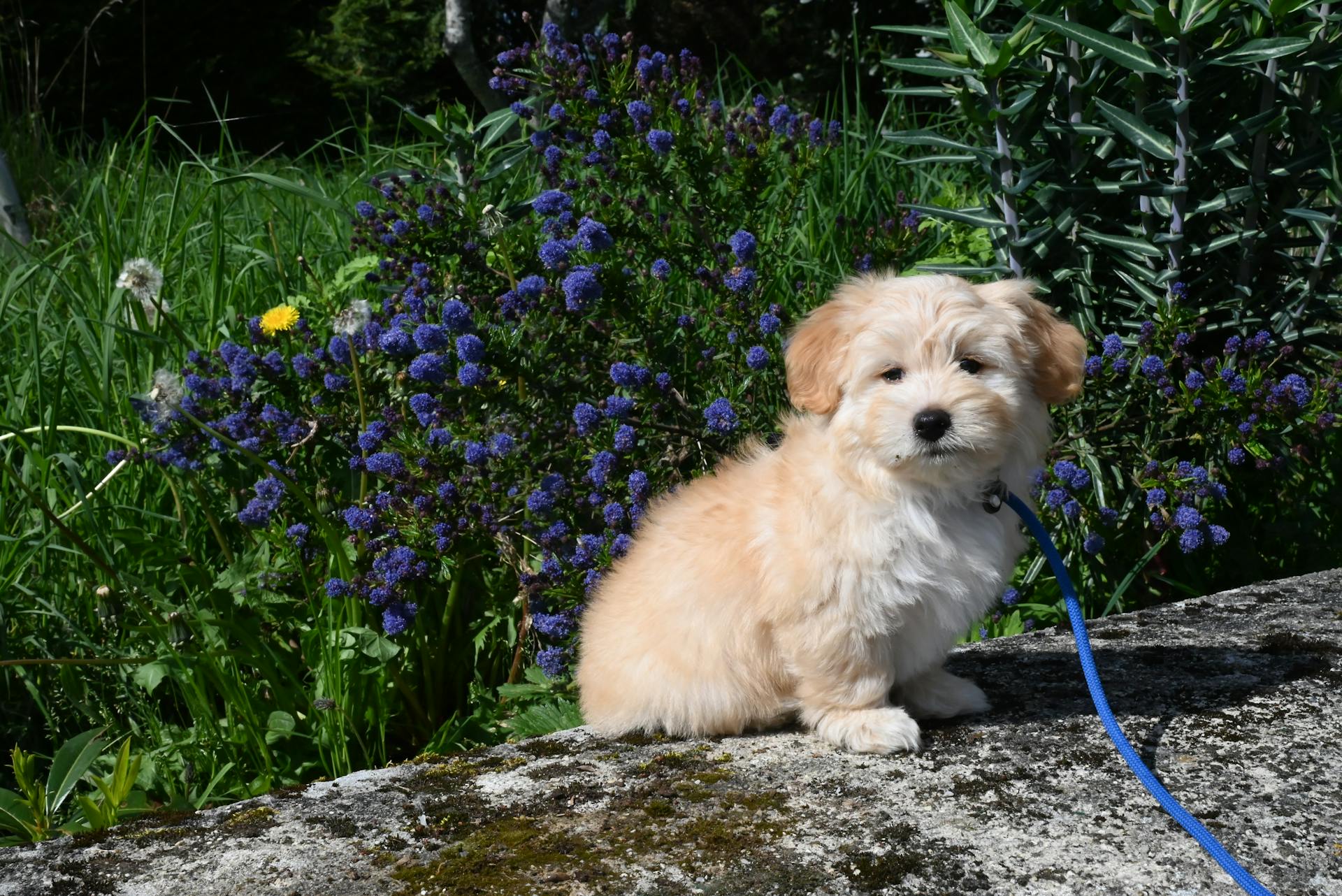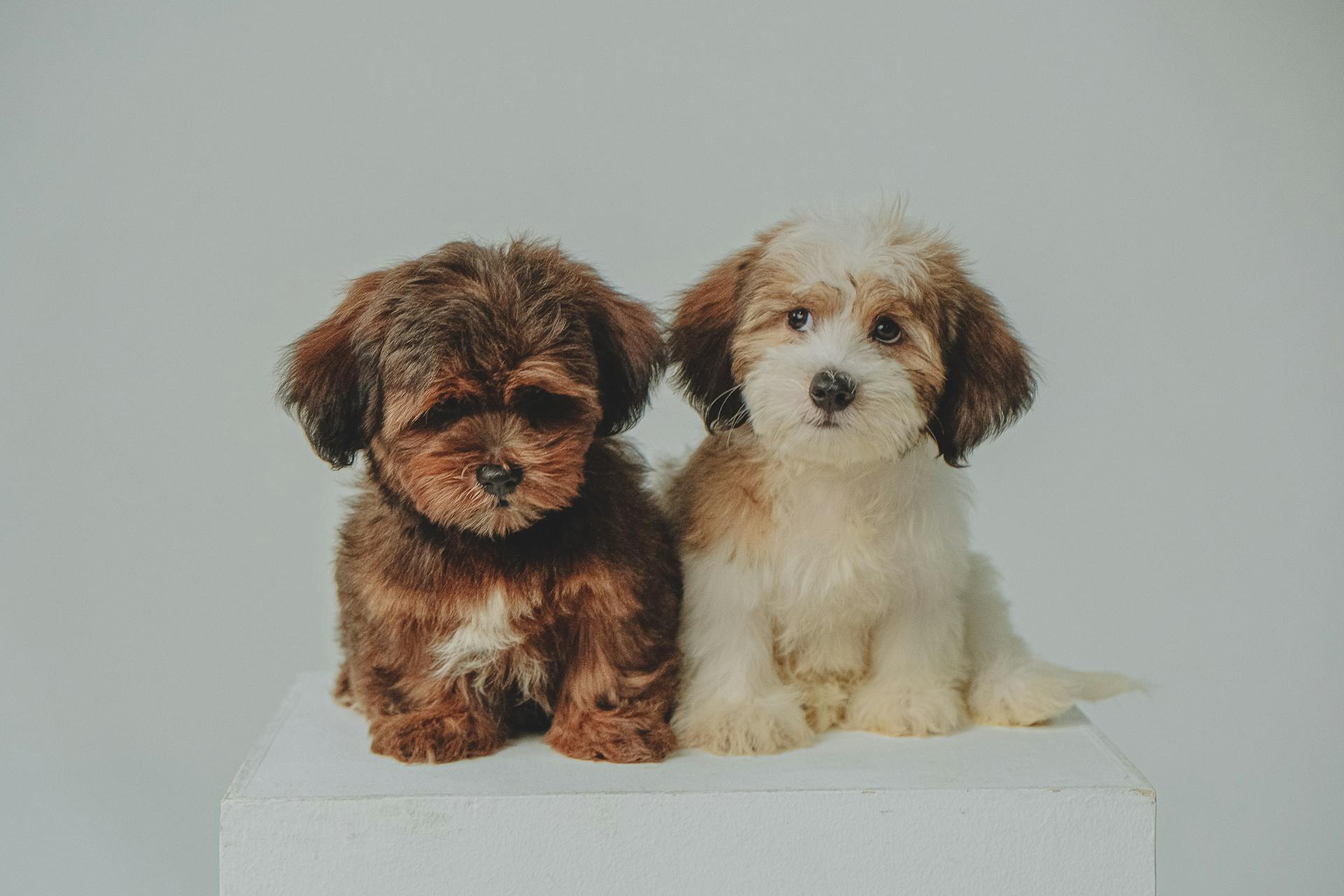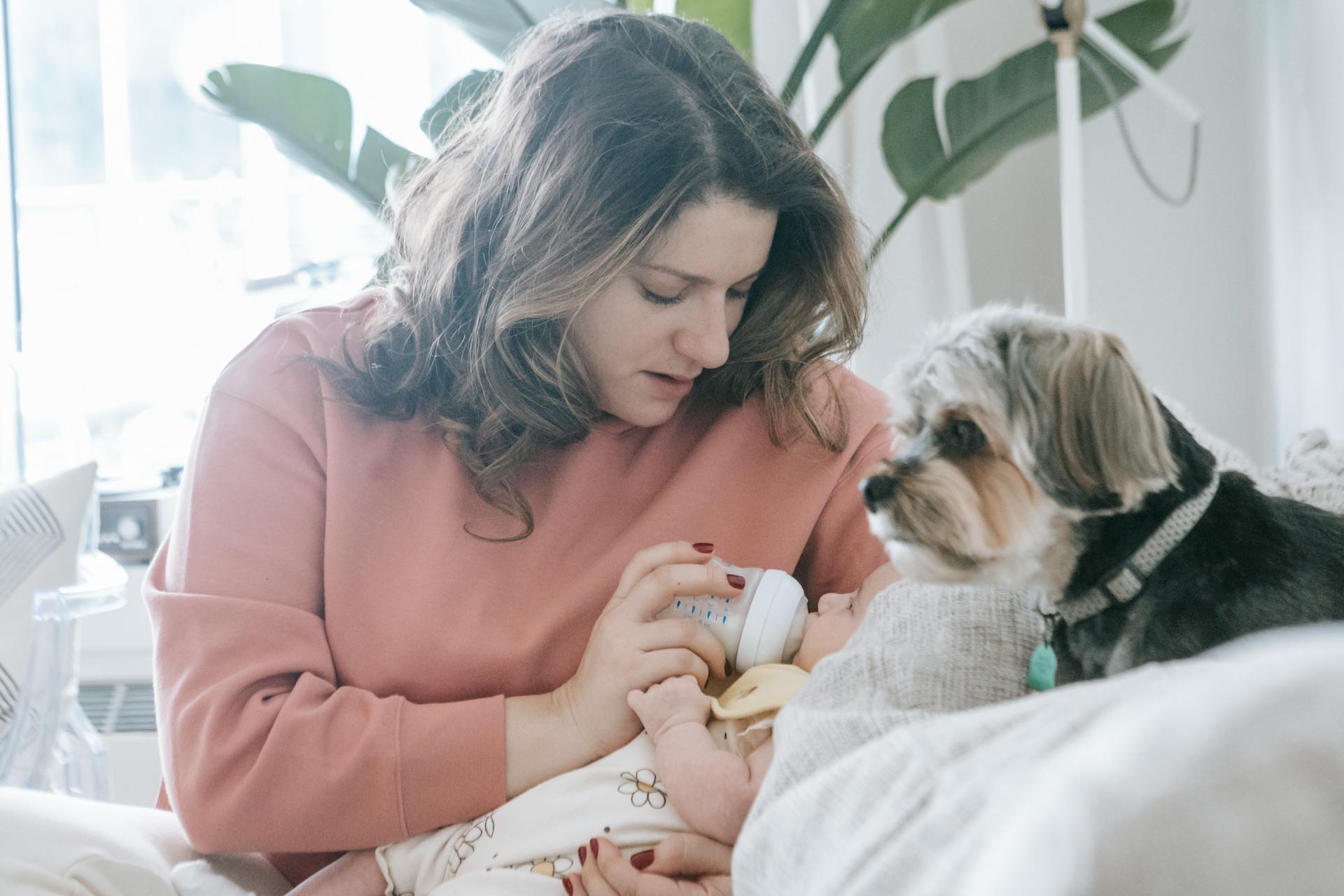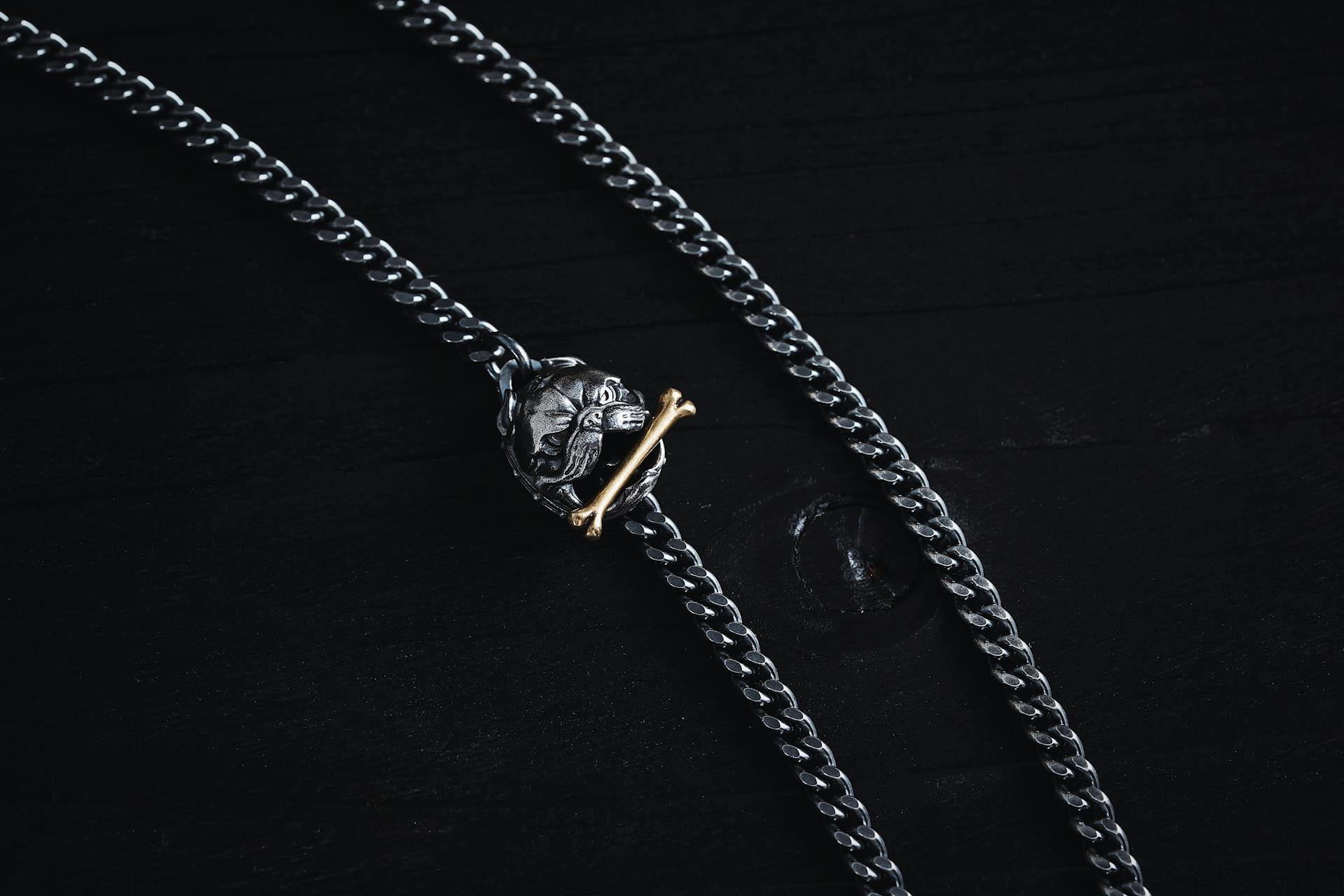
The Perritos Havanese is a small, playful dog breed that originated in Cuba and is known for its silky, hypoallergenic coat.
They typically weigh between 7-13 pounds and stand between 8.5-11.5 inches tall at the shoulder.
These dogs are friendly, outgoing, and love to be around people, making them great family pets.
Their friendly nature also makes them excellent companions for singles and seniors, but they do require regular socialization to prevent shyness.
Caring for a Havanese
Caring for a Havanese is a big responsibility, but it's also incredibly rewarding. They require a moderate amount of exercise, which means daily walks and playtime.
Their medium-length coat needs frequent brushing to stay free of tangles, ideally 3-4 times a week. Using a de-matting spray-on conditioner can help make the process easier.
Havanese dogs can be prone to separation anxiety, so they do best in homes where someone is always by their side. They'll thrive on attention and affection.
Regular grooming is essential, but it's not a round-the-clock job. A yearly visit to the veterinarian for vaccines and a check-up is also necessary.
Basic puppy obedience training is a must, and they'll pick it up quickly due to their high trainability. With patience and consistency, you'll have a well-behaved and loyal companion.
In return for your care, your Havanese will shower you with affection and attention, making them the perfect companion for any family. They'll even keep you company when you're folding clothes or watching a movie.
Health Issues
The Havanese breed is known for its long lifespan, with an average life expectancy of 14-16 years. However, like any breed, they can be prone to certain health issues.
One of the most common health issues in Havanese dogs is patellar luxation, a condition where the kneecaps slip out of place. This can cause pain and lameness.
Havanese dogs are also susceptible to heart disease, which can lead to heart murmurs. If your vet hears a murmur, they may refer your pup to a veterinary cardiologist for further testing.
Worth a look: Havanese Breed Standard

A study of over 90,000 dogs found that Havanese are predisposed to portosystemic shunt, a condition that affects the liver. This is found in 4.35% of Havanese dogs, compared to 0.35% of mixed-breed dogs.
Other health issues that can affect Havanese dogs include liver disease, cataracts, and retinal dysplasia. These conditions can be inherited, so it's essential to work with a reputable breeder who has had their dogs tested for these conditions.
Here are some of the most common health issues that can affect Havanese dogs:
- Patellar Luxation
- Heart Disease
- Portosystemic Shunt
- Liver Disease
- Cataracts
- Retinal Dysplasia
- Sebaceous Adenitis
It's essential to keep an eye out for any signs of these health issues and to work with a veterinarian to prevent or treat them. With proper care and attention, your Havanese dog can live a long and healthy life.
Feeding a Havanese
Feeding a Havanese requires careful consideration to ensure they receive a complete and balanced diet. A commercial kibble or wet food approved by the Association of American Feed Control Officials (AAFCO) is a good starting point.
Havanese puppies need to eat more frequently than adults, with three to four small meals per day on a regular schedule to maintain stable blood sugar. This helps them grow strong and healthy.
The recommended caloric intake for a Havanese varies from dog to dog, depending on their physical size, metabolism, neuter status, and activity level. Your veterinarian can calculate specific caloric needs to determine the right portion sizes.
A high-quality commercial dog food that's balanced and life-stage appropriate is ideal for Havanese dogs. Choose a food that meets your pup's needs, whether they're a puppy, adult, or senior.
Havanese dogs require a balance of carbohydrates, proteins, and fats to stay healthy and lean. Adding omega-3 fatty acids to their diet can be beneficial, especially for skin and joint health.
It's essential to resist the temptation to overfeed your Havanese, as excess weight can put extra strain on their joints. Remember, calories in treats add up quickly, so be mindful of those extra snacks.
Explore further: How Much Food Should a Havanese Eat per Day
Behavior and Training
The Havanese is a breed that bonds quickly with humans, so be prepared for a furry shadow to follow you everywhere. They're intelligent and easy to train, but they can develop separation anxiety if left alone for too long.
Consistency is key when it comes to potty training, as they have small bladders and need to go out frequently. Take your pup out about 20 minutes after every meal and reward them when they potty outside.
Havanese dogs are naturally good at learning new tricks, but they can be a bit stubborn at times. They respond well to treats and praise, and they love to invent new tricks to get a laugh.
Crate training is a great way to help potty train your puppy, as it mimics their natural den-like behavior. Find a crate that fits the "goldilocks" zone, not too small and not too large.
Positive reinforcement is the way to go when training your Havanese, as they avoid negative reinforcement by hiding their accidents. A covered area outside for potty training can also help, as some puppies will avoid going out in the rain.
Related reading: Havanese Potty Training
Havanese dogs are generally pretty good watchdogs, but excessive barking can be a problem if not trained properly. Early socialization and training are crucial to help them learn how to behave in different situations.
Socialization from a young age is essential to help your Havanese puppy become a social butterfly. Introduce them to new people, places, and other dogs in a controlled and calm manner to create positive interactions.
Breed Overview
The Havanese breed is a small but mighty companion dog, weighing in at 7-13 pounds.
Their coats come in a variety of colors, including white, black, chocolate, cream, fawn, gold, red, black and silver, and silver with various markings.
Havanese dogs are known for their fun, smart, and social nature, making them a joy to be around.
Explore further: Havanese Poodle Black
Breed Overview
The Havanese breed is a relatively small dog, weighing between 7-13 pounds.
They come in a variety of colors, including white, black, chocolate, cream, fawn, gold, red, black and silver, and silver with various markings.
Havanese dogs are known for their friendly and outgoing personalities, being fun, smart, social, super trainable, and companionable.
They belong to the same family as Bolognese, Maltese, and Bichon Frise dogs, and are likely descended from the Barbichon dogs living around the Mediterranean.
The American Kennel Club recognized the Havanese breed in 1996, and in 2022, they were the 25th most popular breed according to the AKC's numbers.
Take a look at this: Short Haired Havanese
Origin & History
The Havanese breed has a rich history that spans centuries. The breed is a member of the bichon family of dogs, which originated from Tenerife, an island in the Canary Islands.
The first Havanese dogs were likely brought to Cuba by Spanish colonizers, where they quickly became popular among the island's social elite. They were favored companions of the wealthy and were highly admired by the nobility.
In the 1500s, Havanese dogs first gained favor in Cuba, shortly after the Spanish flag was raised on the island. They were pampered pooches, meant to live a life of luxury and leisure as lapdogs.
The breed was refined with Poodle crosses, which helped them develop into the dogs they are today. This crossbreeding played a significant role in shaping the breed's characteristics.
The Havanese breed was introduced and became popular in the US during the Cuban Revolution, as refugees fled Cuba with their beloved Havanese dogs. Breeders have since worked diligently to grow and improve the breed.
The American Kennel Club (AKC) only officially recognized the Havanese breed in 1996, after a dedicated breeding effort and the acquisition of new dogs internationally.
Appearance
The Havanese dog is a small but sturdy breed with a distinctive appearance. They typically weigh between 7-13 pounds.
Their height ranges from 8+1⁄2 to 11+1⁄2 inches at the withers, with 9 to 10+1⁄2 inches being the ideal height.
The body of a Havanese is slightly longer than it is tall, with a straight but not level topline that rises just slightly from the withers to the croup. Their gait is renowned for being flashy and lively, with a strong rear drive and slightly shorter upper arm producing a springy motion.

The muzzle of a Havanese is full and tapers slightly at the nose, and the length of the skull is equal to the length of the muzzle. The top of the skull is rather flat and the back skull is rounded.
Their eyes are solid black, except for chocolate-colored dogs which may have brown eyes, and are almond-shaped with lids surrounded by black pigment. The ears of a Havanese are broader at the base and set high on the head, and when sitting at attention, they lift but remain folded over.
Here are the different coat colors and marking patterns found in Havanese dogs:
- Coat colors: black, black and silver, brown, silver, fawn, red brindle, black brindle, and white
- Marking patterns: cream marking, parti-color, and more
Puppies
Havanese puppies can be hard to find in shelters, but adult dogs are sometimes available through breed rescue organizations.
Adopting an older dog comes with benefits, as they're usually house-trained and often have less energy than puppies.
Havanese dogs are generally gentle and sociable, but can be reserved around people and animals they don't know.
Broaden your view: Havanese Breeders Washington State
Early socialization of Havanese puppies helps them feel comfortable when meeting new people and pets.
Getting started with obedience training while they're still young is the easiest way to prevent barking from becoming an issue.
Havanese puppies can start learning simple commands like "sit" and "stay" as soon as they come home.
On a similar theme: Havanese Mix Puppies
Grooming and Care
The Havanese's silky coat requires daily brushing to prevent tangles and mats. This is especially true if you leave their coat long.
Their coat can be straight or wavy, and it's essential to brush them at least 3-4 days a week to keep it looking its best. Using a de-matting spray-on conditioner can make the process easier.
Regular grooming is crucial to prevent ear infections, which can be painful and uncomfortable for your pup. Cleaning their ears every 1-2 weeks can help prevent these infections from occurring.
To keep their coat looking its best, consider giving them a short "puppy cut" every now and then. This will make grooming easier and prevent matting.
Related reading: How to Cut Havanese Hair
Don't forget to trim their nails about once a month, or whenever you hear them click-clacking on the hardwood floors. This will keep them comfortable and prevent any potential problems.
Brushing their teeth regularly can help prevent dental disease, which is a common issue in Havanese dogs. Start brushing their teeth early, twice a week, and work your way up to daily.
Grooming Guide
The Havanese breed requires regular grooming to prevent matting and tangling of their beautiful, silky coat. Their medium-length coat can be straight or wavy and requires frequent brushing to stay free of tangles.
Daily brushing is a must for Havanese dogs, especially if you leave their coat long. Brushing helps prevent tangles and mats, and a de-matting spray-on conditioner can be helpful for breaking down tangles.
Regular trips to the groomer for trims can keep your Havanese looking good and make it easier to maintain their coats at home. Short, adorable puppy cuts are popular options, and some owners prefer styling their pets with “corded” cuts.
Havanese dogs need to be brushed at least 3-4 days a week to prevent tangles and mats. Their coat is naturally long and silky, making it prone to matting if not properly cared for.
To keep your Havanese's coat looking its best, use a pin brush for longer hair and a moisturizing spray when brushing. A detangling brush and detangling spray can also be helpful in preventing tangles.
Their facial hair requires special trimming to ensure it stays out of their eyes. Removing wax and debris can help keep ear infections at bay.
Brushing your Havanese's teeth regularly is also essential for their overall health. Start brushing their teeth early, twice a week, and work up to daily brushing to keep their teeth healthy and strong.
Worth a look: Havanese Long Hair
Ear Care
Taking care of your dog's ears is a crucial part of their overall health. Cleaning your dog's ears every 1-2 weeks helps prevent ear infections.
Redness, odor, and/or debris in the ears are signs that an infection may be present. If you notice any of these symptoms, contact your veterinarian right away.
Frequently Asked Questions
What two breeds make a Havanese?
The Havanese breed is believed to have originated from the cross-breeding of the Blanquito and the poodle. This unique combination of breeds has resulted in the Havanese's distinct characteristics and temperament.
What is the cause of death of Havanese dogs?
Heart failure is a leading cause of death in Havanese dogs, often resulting from a weakened heart valve that allows blood to leak back into the heart. This condition can be a significant health concern for Havanese dogs in their golden years.
What is the most popular Havanese color?
The most common coat color for Havanese dogs is black, which can appear solid or combined with other colors.
Featured Images: pexels.com


